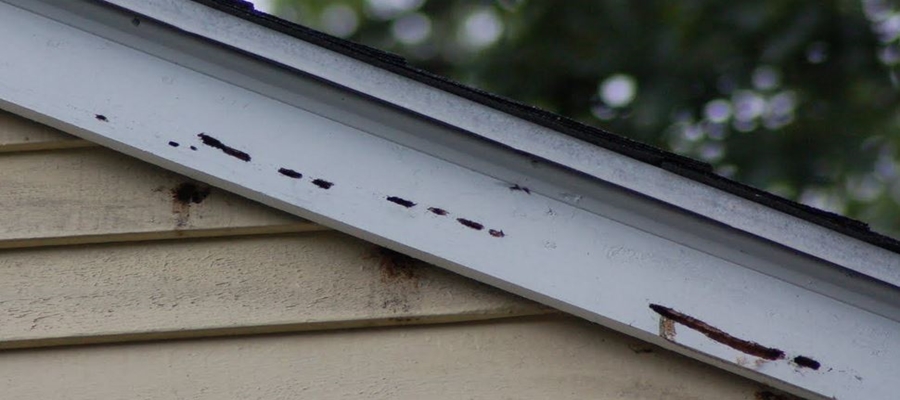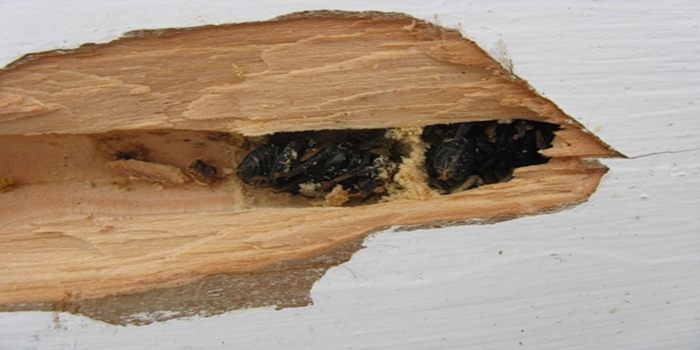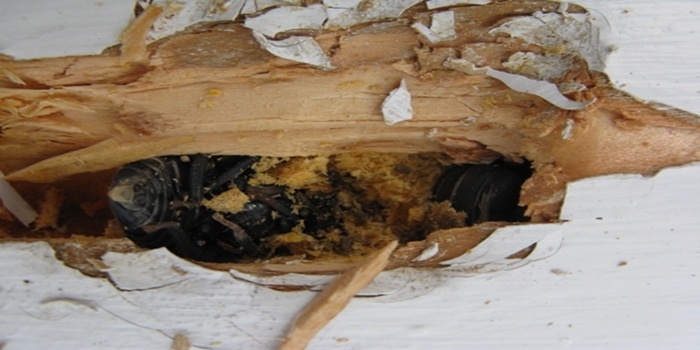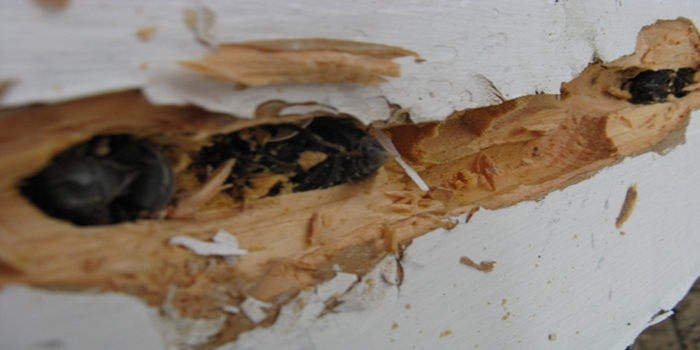Massachusetts Home Inspections YOUR INVESTMENT IS MY CONCERN

Carpenter Bees

Carpenter bees in Massachusetts are large and black and yellow in color. They are most often mistaken for bumble bees because they are similar in color and size, but they do differ in that carpenter bees have a black shiny tail section (abdomen) compared to the bumble bee which has fuzzy yellow hairs throughout the abdomen area. Carpenter bees are frequently seen in the spring time hovering around the eaves of a house or on the underside of a deck and porch railings. The carpenter bee got it's name from its habit of excavating tunnels in wood surfaces with its strong jaws. Carpenter bees (like their distant relatives, the carpenter ants) differ from termites in that they do not consume the wood as food. They simply excavate tunnels in the wood, for nesting and breeding purposes only. They discard the bits of wood from the entry hole areas or they will use it to make partitions (walls) inside the tunnels of their nests.

They can become a nuisance outdoors when they fly erratically (hover) around the heads of people, causing fear. However, male carpenter bees cannot sting (they do not have stingers) but female carpenter bees will sting if she is bothered in any way, but she is normally very docile. It is possible to identify the male from a female carpenter bee but you must be very careful when approaching them up close. The males will have a patch of white cuticle on their face, as opposed to the females, whose faces are completely black.
Homeowners complain not only about the aggressive nature of these bees, but about the round holes that are bored into the wood trim near eaves and gables of homes, fascia boards, porch ceilings, outdoor wooden furniture, decks, wood siding and window frames. Initial damage is usually minor, but new tunnels may be excavated and old ones enlarged, causing considerable wood damage. The yellow, coarse sawdust from borings beneath their entry holes will contain their waste materials, leaving unsightly stains throughout your property.
The males and females cut 1/2" to 3/8" inch circular entry holes into the wood (See images below). After creating a relatively short entrance, the female carpenter bee will turn 90 degrees and bore a channel from 6 inches to as long as 4 feet. This channel serves as a main corridor from which she will drill additional smaller chambers a few inches deep. These chambers become her egg holders. She will deposit an egg, bring in a mass of pollen for the newly hatched larvae to feed on, and then seal it all off to ensure its development before she repeats the process for the next egg.
INFESTATION IMAGES
This is an actual Carpenter Bee infestation that I have encountered on my own property. I am going to show you images (up close) in order for you to see how these Bees actually set up camp for breeding.
1) Upon finding the Carpenter Bee damage, I carefully peeled away the most outer surface of the wood trim in order to take a closer look inside the small breeding chambers. You can clearly see the newly born bees lying in their chambers.

2) Following the bored tunnel, I carefully peeled away additional layers of wood and I find two additional chambers with newly born bees lying inside the chambers.

3) As I continue to follow the long bored tunnel, I find another bee on it's back.

4) Here is the entire tunnel with the wood covering removed. This particular tunnel was approximately 9-10 inches long.

CARPENTER BEE PREVENTION
Preventing carpenter bee damage is difficult (or nearly impossible) for several reasons. Protective insecticide sprays applied to wood surfaces are effective for only a short period of time, even when repeated every few weeks. Since the bees are not actually eating the wood and they are active over several weeks, they are rarely exposed to lethal doses of the pesticide. Second, since virtually any exposed wood on the house could be attacked, it is difficult and usually impractical and unsafe to try applying a pesticide to all possible sites where the bees might tunnel. Lastly, trying to spray bees that are seen hovering about is not a sensible (or particularly safe) use of pesticides either. Swatting hovering bees will often prove to be just as effective.
If possible, susceptible exterior parts of a building should be constructed out of hardwoods not normally attacked by the bees for nests. On all buildings, fill depressions and cracks in wood surfaces so they are less attractive. Paint or varnish exposed surfaces regularly to reduce weathering. Fill unoccupied holes with steel wool and caulk to prevent their reuse. Wait until after bees have emerged before filling the tunnels. Once filled, paint or varnish the repaired surfaces. Protect rough areas, such as ends of timbers, with wire screening or metal flashing.
Here is what my clients have to say about my home inspection services:
Press F5 (on your keyboard) for additional testimonials
Dave,
I want to thank you for doing my home inspection. I appreciated your extremely detailed documentation and will certainly use you for any other home inspection needs if i ever have them.
Aaron














